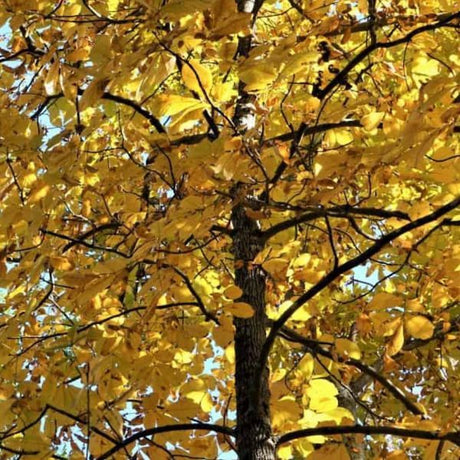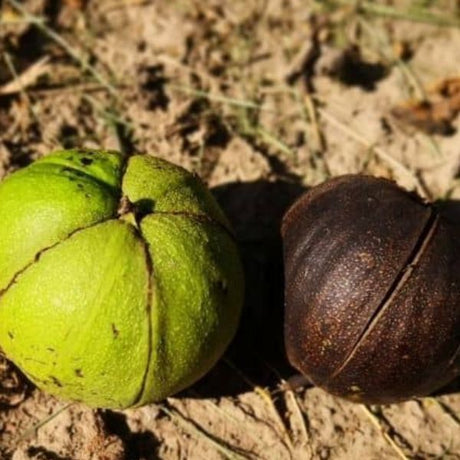Hickory Trees At NatureHills.com!
Native ease, flavorful nuts and mast for wildlife, and lush shade, Hickory Trees are a long-lived keystone species! Native nut trees, Hickories fall into the genus Carya and are deciduous hardwood trees.
The most commonly known types of Hickory include Shagbark, Shellbark, Mockernut, Pignut, Pecan and Bitternut.
The Hickory tree produces spring catkins like Birch Trees but in groups of 3. Each is either a male or female tree (with the exception of some that are both and therefore self-pollinating). Female trees or female flowers will produce edible nuts that are encased in very hard shells, which typically need a nutcracker to open.
All Hickory trees are known for their hard nuts, except for the closely related Pecan (also Carya spp.). Pecans and all Hickory are excellent trees for use in the home landscape, a great provider of nuts and shade!
Look through our selection of Hickory Trees, or check out these popular selections:
- Shagbark Hickory Tree - iconic shaggy bark
- Black Hickory Tree - Very tall and wide with dark furrowed bark
- Shellbark Hickory Tree - Especially shaggy bark and thin-shelled nuts
- Pignut Hickory Tree - Lemony fall color and valuable wildlife resource
The nuts form green husks that dry to brown before splitting and revealing the pointed round-to-oval light-shelled nut inside.

How To Use Hickory Trees In Your Landscape
Landscapers and homeowners love the Hickory tree not only for its nuts but also for its lush shade and for its high, sturdy branches. Add to your windbreak and mixed tree canopies and are great for blocking drifting snow while handling heavy snow loads.
Perfect lawn and specimen trees, these are lovely to adorn your front or backyard but give them some room to grow. These are fantastic lawn and shade trees! You'll enjoy reduced cooling costs and increased home equity with a large long-lived tree like a Hickory. Plant in large open spaces and big backyards so a single tree can shade the entire area.
These keystone species will attract and shelter wildlife, squirrels as well as songbirds to your landscape. The lush leaves are long and alternately pinnate, a steady green with toothy serrated margins. Additionally, several species of butterfly and moth use Hickory as Host Plants for their larvae!
Hickory wood has long been used for flooring because of its toughness and attractive appearance. Hickory tree wood is also one of the preferred woods for barbecue and hickory smoked meats. Hickory trees are long-lived and as a general rule, produce hard, strong, and stiff lumber! You don't need to cut your tree down but Hickory has a star-shaped pith in the center!
Since these trees can be either male or female, be sure to plant in groups and create your very own nut tree grove or nut orchard, mixing your Hickory with other varieties for a larger harvest - for both yourself and your wildlife!
FAQ's for Buying Hickory Trees Online
What are the best Hickory tree varieties for nut production and flavor?
What are the best Hickory tree varieties for nut production and flavor?
Shagbark and Shellbark Hickory trees are considered the best-tasting nut producers, with rich, sweet flavors similar to pecans or walnuts. Kingnut and Black Hickory also yield flavorful nuts. While all Hickory nuts are technically edible, varieties like Bitternut and Pignut tend to be more bitter or less palatable.
How fast do Hickory trees grow and when do they start producing nuts?
How fast do Hickory trees grow and when do they start producing nuts?
Hickory trees grow at a moderate rate and typically begin producing nuts between 15 to 20 years of age. Once mature, they can deliver reliable annual crops, especially during mast years, which occur every few years with an extra-abundant harvest.
Where can Hickory trees grow in the United States?
Where can Hickory trees grow in the United States?
Hickory trees are native to the Eastern U.S. and thrive in a wide range of climates from USDA growing zones 4 to 9. This makes them suitable for both cold Northern regions and warm Southern states, especially in areas with well-drained soil and full sun.
Are Hickory trees good for landscaping and shade?
Are Hickory trees good for landscaping and shade?
Yes, Hickory trees are excellent for providing deep shade, enhancing wildlife habitats, and contributing to large-scale landscape aesthetics. Their strong branches, attractive bark, and lush foliage make them ideal for use as lawn trees, specimen trees, and components of windbreaks or wildlife plantings.
How do I plant and care for a Hickory tree?
How do I plant and care for a Hickory tree?
Plant Hickory trees in full sun with well-drained soil. Use mulch to conserve moisture and suppress weeds, and water regularly until established. Prune in late winter and space multiple trees for cross-pollination if nut harvest is a priority. Avoid poorly drained sites or use raised berms to improve drainage.



